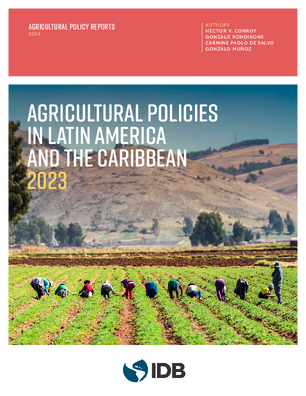Agricultural Policies in Latin America and the Caribbean 2023
Date issued
Aug 2024
Subject
Agricultural Policy;
Fishery;
Export;
Greenhouse Gas Emission;
Agricultural Productivity;
Gross Domestic Product;
Agricultural Production
JEL code
Q10 - Agriculture: General;
O54 - Latin America • Caribbean;
Q17 - Agriculture in International Trade;
Q58 - Government Policy
Category
Monographs
Agriculture is a key economic sector in Latin America and the Caribbean (LAC), accounting for nearly 7% of the region's GDP, though with significant heterogeneity. For instance, its contribution to GDP is less than 4% in countries like Mexico and Chile, while it exceeds 15% in Belize and Nicaragua, and reaches 20% in Paraguay. Between 2017 and 2022, both exports and economic growth progressed at a slower pace compared to previous periods.
This report, the third in its series, systematically analyzes agricultural support policies in 25 LAC countries using the OECDs Producer Support Estimates (PSE) methodology, as systematized by the IDBs Agrimonitor initiative. Overall, agricultural support represents a low percentage of the region's GDP (1.3%) and its agricultural GDP (16%) compared to support levels in the European Union, Canada, and the United States. The main source of support comes from market price distortions, which on average account for 75% of the Producer Support Estimate. Public Agricultural Expenditure accounts for 5% of the regions agricultural GDP. A decline in budgetary investment in agriculture was observed in 17 LAC countries over the average of the last three available years compared to the previous three-year period. Literature has highlighted the importance of investment in agricultural public goods and the need for countries in the region to allocate more resources to these types of support to boost productivity and competitiveness.
The report also highlights the efforts of various countries in the region to promote environmental sustainability in the sector through policies encouraging the adoption of sustainable practices and technologies. The data reveal that, so far, there is no clear relationship between greenhouse gas (GHG) emissions from agricultural products and the level of policy support they receive.
Finally, the report examines support for fisheries and aquaculture through the Fisheries Support Estimate (FSE), revealing significant differences in the levels and composition of support across the countries analyzed. For instance, countries such as Argentina, the Bahamas, Colombia, and Peru allocate the majority of their support to public goods, whereas Costa Rica, Brazil, and Suriname provide support directly to their fishers.
This report, the third in its series, systematically analyzes agricultural support policies in 25 LAC countries using the OECDs Producer Support Estimates (PSE) methodology, as systematized by the IDBs Agrimonitor initiative. Overall, agricultural support represents a low percentage of the region's GDP (1.3%) and its agricultural GDP (16%) compared to support levels in the European Union, Canada, and the United States. The main source of support comes from market price distortions, which on average account for 75% of the Producer Support Estimate. Public Agricultural Expenditure accounts for 5% of the regions agricultural GDP. A decline in budgetary investment in agriculture was observed in 17 LAC countries over the average of the last three available years compared to the previous three-year period. Literature has highlighted the importance of investment in agricultural public goods and the need for countries in the region to allocate more resources to these types of support to boost productivity and competitiveness.
The report also highlights the efforts of various countries in the region to promote environmental sustainability in the sector through policies encouraging the adoption of sustainable practices and technologies. The data reveal that, so far, there is no clear relationship between greenhouse gas (GHG) emissions from agricultural products and the level of policy support they receive.
Finally, the report examines support for fisheries and aquaculture through the Fisheries Support Estimate (FSE), revealing significant differences in the levels and composition of support across the countries analyzed. For instance, countries such as Argentina, the Bahamas, Colombia, and Peru allocate the majority of their support to public goods, whereas Costa Rica, Brazil, and Suriname provide support directly to their fishers.
Generative AI enabled




